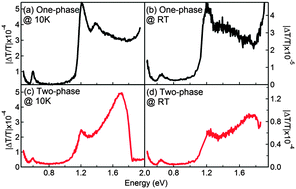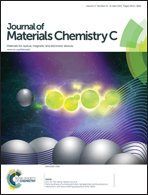The effect of phase morphology on the nature of long-lived charges in semiconductor polymer:fullerene systems
Abstract
In this work, we investigate the effect of phase morphology on the nature of charges in poly(2,5-bis(3-tetradecyl-thiophen-2-yl)thieno[3,2,-b]thiophene) (pBTTT-C16) and phenyl-C61-butyric acid methyl ester (PC61BM) blends over timescales greater than hundreds of microseconds by quasi-steady-state photoinduced absorption spectroscopy. Specifically, we compare an essentially fully intermixed, one-phase system based on a 1 : 1 (by weight) pBTTT-C16 : PC61BM blend, known to form a co-crystal structure, with a two-phase morphology composed of relatively material-pure domains of the neat polymer and neat fullerene. The co-crystal occurs at a composition of up to 50 wt% PC61BM, because pBTTT-C16 is capable of hosting fullerene derivatives such as PC61BM in the cavities between its side chains. In contrast, the predominantly two-phase system can be obtained by manipulating a 1 : 1 polymer : fullerene blend with the assistance of a fatty acid methyl ester (dodecanoic acid methyl ester, Me12) as additive, which hinders co-crystal formation. We find that triplet excitons and polarons are generated in both phase morphologies. However, polarons are generated in the predominantly two-phase system at higher photon energy than for the structure based on the co-crystal phase. By means of a quasi-steady-state solution of a mesoscopic rate model, we demonstrate that the steady-state polaron generation efficiency and recombination rates are higher in the finely intermixed, one-phase system compared to the predominantly phase-pure, two-phase morphology. We suggest that the polarons generated in highly intermixed structures, such as the co-crystal investigated here, are localised polarons while those generated in the phase-separated polymer and fullerene systems are delocalised polarons. We expect this picture to apply generally to other organic-based heterojunctions of complex phase morphologies including donor:acceptor systems that form, for instance, molecularly mixed amorphous solid solutions, underlining the generality of the understanding gained here.


 Please wait while we load your content...
Please wait while we load your content...